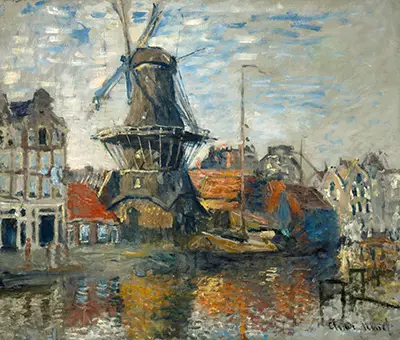To the modern mind windmills are remembered exclusively for turning huge stones to grind flour for baking from grains but the power generated by mills was important for a much wider range of uses.
During the Industrial Revolution, entrepreneurs used mills to harness the movement of the wind or nearby streams and provide power to drive a wide range of machinery.
Like many others at the time, Claude Monet was fascinated by this new technology and many of this celebrated artist's most iconic views use windmills as both a main focus of an image, as we see here, or as a structural device to break up or balance a wider landscape or cityscape.
In "The Windmill, Amsterdam" the mill itself is very much the subject of the painting.
Sitting on the Onbekende Canal, it had been built in the late 17th century and had most recently powered equipment used to extract natural red, yellow and blue dyes from plant material. Therefore this mill had a particular resonance for Monet and fellow artists as it was the source of many of the paints and pigments they used in their work.
While, for many, the presence of two sailing barges moored on the bank next to the windmill may have provided a more conventional focus of the view, we can see than, for Monet, these were no more important than the neighbouring cluster of canalside warehouses, apartments and shops in creating a setting and sense of place for the imposing old mill.
This part of Amsterdam's waterfront has attracted countless artists over the centuries and the attention of most was (and still is) grabbed by the picturesque Magere Brug (Skinny Bridge) over the Amstel river. Thousands of paintings of that more obvious subject have been created but part of the genius of Monet was to bring out the hidden fascination in this more industrial subject.
To the public of the period, Monet's subject matter and his new impressionist painting technique was shocking but over the century since, the conventional views of his contemporaries have fallen from favour and Monet's genius has brought him international acclaim.
The critics' view of work by impressionist artists such as Monet, Renoir and Degas has been enhanced by time but contemporary viewers were struck by the lack of sentimentality in their images of modern industrial subjects such as windmills, all captured in bright colour through their new impressionist technique.
Today, far from being the shocking splatter of colour they were initially condemned as, Monet's works are as likely to be found on the lid of a chocolate box and cover of a greeting card as they are on the walls of some of the world's most revered art galleries.
For those of us that have enjoyed many of the famous paintings which have appeared since the start of the impressionist movement, we owe a great deby of gratitude to the likes of Monet who pushed artistic development onwards towards all that we enjoy today. Highlights would include The Kiss by Gustav Klimt, Nighthawks by Edward Hopper and Yellow Cow by Franz Marc.
Although by the time Monet painted this image in 1874, this chemical works' importance had largely been overtaken by the development of synthetic dyes, the artist's composition seems to reference more than a simple reflection of the old mill in the canal but also indicates its (literally colourful) history seeping out into the water.
Two years after its contribution to artistic life in Amsterdam was celebrated by Monet, this windmill was dismantled and shipped to Leusden in Utrecht where it was reassembled to begin a new chapter in its life powering a new type of machinery.


